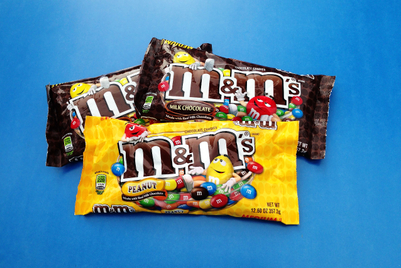
The snack food industry is constantly evolving, shaped by changing consumer tastes and lifestyles. Convenience, health, and indulgence are key drivers, leading to a diverse range of snack options. Global snack sales have constantly been on the rise, driven by busy lifestyles, on-the-go consumption, and the demand for quick, satisfying bites.
According to Statista, the global market is expected to grow annually by 6.13% (CAGR 2024-2028) with the average volume per person in the snack food market expected to amount to 9.2 kilograms in 2024.
“India being home to the largest population in the world out of which 70% are Gen Z and millennials, a lot of excitement exists around the snacking industry in the country”, Nikhil Rao, chief marketing officer at Mars Wrigley India told Campaign Asia-Pacific. Mars Wrigley in India focuses on chocolate and confectionery brands.

As urbanisation drives an increase in consumer spending, the Indian snack industry is set for substantial growth, projected to reach US $23.69 billion by 2028. Companies are adapting their offerings to align with local consumer preferences to capitalise on this growth.
Rao explained “the evolving tastes in the Indian market include a growing preference for fusion flavors. Consumers seek comfort in familiar foods while also embracing global tastes. Additionally, there is a desire for Western foods with local appeal, reflecting a shift towards more diverse and international flavor profiles.”
Two examples of fusion flavors by Mars are Snickers Kesar Pista and Doublemint betel flavor, specially crafted to highlight the blend of flavors for the Indian market.
The fast paced world of today is also seeing convenience become a top priority. Rao sees the trend of rising preference for “on-the-go snacks” in the Indian market.
The third trend of note is health and wellness as consumers globally are more aware of what they are eating, and India is no different. Elaborating on this trend in the country Rao mentioned how Mars Wrigley has worked with consumers and segmented this market into four types.
First, consumers are seeking the same tastes, but without guilt, driving demand for portion control. “This has made us offer packs under 12 grams across our brands, available in multi-packs, share bags, and as individual units," shared Rao.
Rao underscored health and well-being trends noting, 'Another important aspect is fortification, where consumers seek products enriched with essential macro or micronutrients.”
The third segment would be consumers looking for snacks or confectionery which have ingredients that are better for them as they try to stay fit”, he added.
The fourth trend, according to Rao, is Ayurveda - a major influence in the country, driving many brands that are not necessarily in the snacking space but are focused on promoting natural and traditional ingredients.
Do it the way Gen Z does it
Gen Z and Gen Alpha are rising as the dominant consumer groups worldwide, shaping the global food and snacking landscape with their unique preferences and requirements.
With a median age of 28 and about 65% under 35, India's 1.4 billion population includes over 910 million millennials and Gen Z with a large chunk of this number being the latter.
These Gen Zers are increasingly shaping brand marketing strategies, being digital natives with limited attention spans. Research conducted by Microsoft found that the average attention span of Gen Z was only about eight seconds, four seconds less than that of millennials.
Rao observes an increasing prevalence of short-format videos across social media platforms and advertising channels, to cater to this segment. In terms of marketing, there are five things that Gen Z consumers in India look for and brands are trying to attune to shared Rao.
“The first thing is authenticity, preferring brands with honest, strong personalities and a clear purpose, such as our brand Galaxy, which stands for empowering women. They also value diversity and expect brands to take a stance on important issues,” noted Rao.
The third trend revolves around this consumer base being exceptionally digital first.
“The GenZ have a strong preference for personalised content. Approximately 81% indicate a desire for brands to establish personal connections and use addressable media to target them based on their specific needs. They are heavily engaged in gaming and use platforms like Snapchat,” Rao said.
Sustainability is also a key concern for Gen Z, as they are environmentally conscious and expect brands to be as well, according to Rao.
This generation is also a highly interconnected and globally conscious audience. They actively seek out communities of like-minded individuals, often forming global networks through social media and blogs.
“This generation creates and participates in interest groups, and they closely follow influencers. Brands can effectively engage with Gen Z by recognising and leveraging these community-driven behaviors,” shared Rao.
Modern consumers globally prioritise experiences over possessions, turning food and snacks into affordable, experiential adventures in taste and flavor.
Rao said for Gen Z in India, “Marketers should note that this generation in India also values experiences more over material possessions and this needs to be taken into the marketing approach”.
Marketing to the millennials and the older generation
Despite consumer concerns about inflation and rising living costs, interest in premium food products is steadily increasing worldwide. This trend is driven by various demographic and societal factors. India is also seeing a heightened taste for luxury and premium products.
Rao shed some light on this space as he said, “Indian millennials at the peak of their earning stage are aspiring for premium and luxury lifestyle brands, showcasing a high degree of premiumisation in the Indian market compared to Southeast Asia and other emerging markets.”
He added, “They have more of an attention span than Gen Z and are often targeted by marketers with around fifteen-second average commercial duration, focusing on their high family income and affinity for lifestyle branding.”
Interesting trends in marketing can also be observed in India for the generation that is five to ten years away from retirement and is possibly focused on prudent spending.
Rao shared how this generation is not fully engaged in ecommerce like the millennials and is often seen in supermarkets.
“Brands that evoke trust and security perform well with this group, and testimonials are effective. Loyalty programs and discounts are also successful with this audience”, he noted.
Social media versus traditional media and the Indian approach
In a country as vast and diverse as India, there is no denying that social media marketing offers immense opportunities for brands to grow, yet traditional media also carries a huge importance. For Rao moving from a Southeast Asia (SEA) role at Mondelez to join Mars Wrigley in India, this was different.
“Unlike SEA, I think in India, a lot of the marketing is still led by television. Television drives about 70 to 80% of our reach which includes OTT channels that provide compelling content and form a backbone of our media strategy followed by social media,” he shared.
TV long-form storytelling and 30-second TV advertisements are still very prevalent in India added Rao, unlike some of the other SEA countries.
The growth of ecommerce
The rapid advancement of technology is transforming the retail landscape, enabling instant purchases from anywhere at any time. This shift is reshaping shopper behavior and raising expectations for greater convenience and a more positive shopping experience.
Digital commerce is a fast growing aspect of the Indian market that marketers should not ignore. It is rapidly changing the way India shops and it is often said that quick commerce (delivery in one hour or less) is competing with offline stores on convenience.
For Rao, digital commerce presents opportunities for marketers to build brands and implement performance marketing. Performance marketing, including tactics like paid search, can be important for brands to get noticed and to promote specific products or offerings.
“While mass media remains a significant part of Mars Wrigley's budget, they are also focusing on brand marketing through online platforms like Amazon, Flipkart, and Swiggy. “This includes using banners and other forms of digital advertising to promote their brand and offerings and for increased visibility on the platforms”, noted Rao.
The role of GenAI
GenAI can enhance various stages of the marketing campaign funnel. This includes leveraging the technology for market research, automating processes like layout generation and content creation, and optimizing campaign performance. Rao sees GenAI for marketers in India still being at pilot stage.
“We are closely monitoring the policies and rules regarding AI usage, for now as we want to avoid any consumer issues caused by Gen AI taking liberties and sharing inappropriate content,” shared Rao.
“While we have conducted some pilots, we haven't fully implemented AI in a significant way yet,” he added.




.jpg&h=334&w=500&q=100&v=20250320&c=1)
.jpg&h=334&w=500&q=100&v=20250320&c=1)



.jpg&h=334&w=500&q=100&v=20250320&c=1)
.png&h=334&w=500&q=100&v=20250320&c=1)

.jpg&h=268&w=401&q=100&v=20250320&c=1)



.jpg&h=268&w=401&q=100&v=20250320&c=1)


